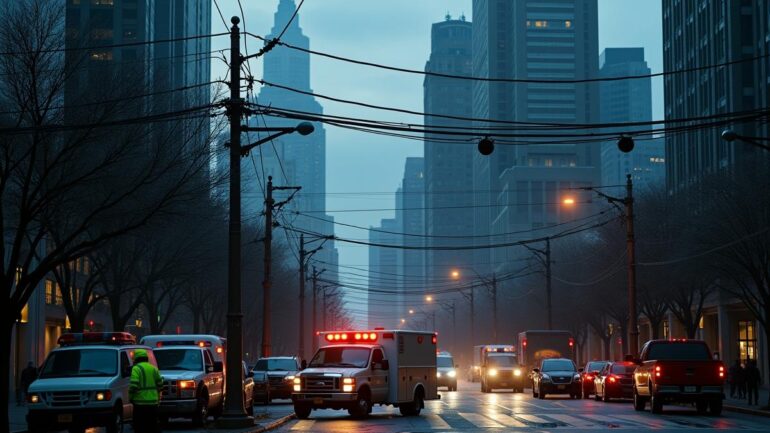After a car accident, understanding who is liable can often be confusing. You might stand at the side of the road, exchanging insurance information and wondering how fault gets determined when things don’t seem entirely clear.
Most drivers worry about potential car crash responsibility, and that’s understandable. After all, deciding who should pay for vehicle damage, medical bills, and lost wages is rarely straightforward. In many cases, the decision depends on a precise combination of evidence, traffic law, and individual behavior in the moments leading up to the crash.
How Fault Is Established in Collisions
Figuring out fault in car collisions often begins at the crash site. This process, known as liability determination, involves collecting details like photos, witness statements, and an official accident report. Each piece of evidence can help insurance companies, law enforcement, and, if necessary, the courts piece together what really happened.
Some drivers decide to handle vehicular accident claims through basic phone calls to their insurer, while others might need legal help if the crash involves multiple parties or high-dollar losses. Whether you decide to pursue personal injury claims or opt for a settlement negotiation, skipping the fact-finding process can lead to complications later on.
Police Reports and Their Impact
When law enforcement arrives, they’ll gather immediate information and note any potential causes of car crashes, such as reckless driving or speeding. Their accident report might not always finalize fault determination, but it plays a huge role in guiding insurance coverage for accidents. This official perspective can influence a compensation claim, especially if one party clearly violated traffic law.
Keep in mind that even a well-detailed police report isn’t the final word. Insurance providers, attorneys, or courts can reach different conclusions after analyzing videos, collision coverage policies, and additional records. If you suspect a factual error in the report, you have the right to request corrections or add your own statement.
The Role of Negligence in Car Accidents
At the core of auto accident liability lies the concept of negligence. Essentially, it means someone acted carelessly or failed to follow a recognized standard of care while driving. This lapse can include texting behind the wheel, ignoring safety regulations and liability requirements, or failing to stop at a red light.
Negligence in car accidents comes in different forms. One driver might be speeding, while another could fail to yield. If either person’s actions contribute to the crash, that individual could hold part or all of the legal responsibility. Sometimes both drivers share fault, which leads to a broader analysis of comparative negligence laws in many states.
Insurance Coverage for Accidents: What You Need to Know
Proper insurance coverage is crucial when the unexpected happens. Not all auto insurance policies look alike, but most offer liability coverage that pays for bodily injury or property damage if you’re found at fault in a crash. Depending on your policy, collision coverage helps repair your own vehicle regardless of who caused the accident.
Accident liability insurance is also significant for drivers facing personal injury or property damage claims. States have different minimum coverage requirements, though it’s often wise to purchase more than the minimum. If an uninsured motorist is involved, things can get tricky, and you may need to rely on your insurer for subrogation against the other party.
Liability Coverage and Collision Coverage
Liability coverage focuses on compensating victims when you’re deemed responsible for a wreck. On the other hand, collision coverage is about protecting your own assets. If you lease or finance your car, your lender will likely insist you carry both types.
You also want to consider comprehensive coverage for non-accident-related losses, such as theft or vandalism. Each policy detail plays a role when settling accident claims, and it helps to review your paperwork before an emergency occurs. A quick call to your agent can clarify any confusion, ensuring you’re aware of your policy’s specifics, including collision limits and deductibles.
Legal Proceedings and Determining Responsibility
When two parties disagree about fault in car collisions, legal intervention might be unavoidable. In some cases, a well-documented insurance claim process is enough to reach a fair settlement. However, if the dispute escalates, attorneys may step in to protect their clients’ rights. Seeking the assistance of experienced road traffic accident solicitors can be important in handling the challenges of legal proceedings. They can take care of gathering and presenting evidence, negotiating with insurance companies, and ensuring fair compensation for their clients.
Court proceedings can address driver responsibility in accidents by reviewing all available evidence, which might include motor vehicle accident scene footage, accident reconstruction reports, and expert testimony. Each side tries to show the other party was more at fault, hoping to shift the bulk of financial liability elsewhere. In these moments, having thorough records of medical care, vehicle repairs, and witness statements can tilt decisions in your favor.
Handling Court Proceedings
If you move forward with a lawsuit, be prepared for the possibility of going to trial. Although many cases reach settlement negotiation long before facing a judge, you never know how stubborn the other side will be. A skilled attorney can guide you regarding court proceedings, helping you gather any missing evidence or line up key testimonies.
Judges take various factors into account, including traffic citations, accident report details, and how parties responded immediately after the crash. Documenting everything from hospital visits to property damage estimates strengthens your argument. It also showcases a proactive approach to demonstrating fault or absolving yourself of certain accusations.
Common Scenarios That Affect Liability
One of the most frequent causes of car crashes is distracted driving. Whether it’s texting, checking a navigation app, or grabbing something from the passenger seat, these simple acts of negligence jeopardize everyone on the road. Distracted drivers risk fines, insurance rate hikes, and possible personal injury lawsuits if they harm others.
Another important scenario involves liability waivers for car rentals. Even if you sign a waiver, you could still face partial responsibility if your negligence led to an accident. Similarly, when companies rent out vehicles, they’re required to maintain certain safety standards, but that doesn’t exempt a driver from following motor vehicle accident laws. Defensive driving and liability awareness go a long way toward preventing mishaps and expensive legal battles.
Shared Fault and Comparative Negligence
Sometimes fault is split between more than one party. States follow different rules on how to assign this proportional blame. A driver could be 40% at fault, while the other person bears 60% responsibility. Depending on where you live, you might still recover some compensation for car accidents even if you contributed to the crash.
If your actions contributed to the wreck, your compensation might be reduced. So practicing defensive driving helps minimize potential damage, protect others, and strengthen your stance if fault determination becomes a messy affair. Insurance companies and courts look closely at each driver’s role, so staying informed about automobile liability laws helps protect your rights.
Contributory Negligence vs. Comparative Fault
In states that follow contributory negligence rules, any wrongdoing on your part might nullify your claim altogether. This approach is extremely strict and can leave partially negligent drivers without needed compensation. By contrast, most states lean toward a comparative fault model, which calculates awards based on the percentage of each party’s negligence.
Anyone trying to sort through these laws should keep thorough records of their actions and gather as much evidence as possible. Letters from insurance claims professionals, emails about repair estimates, and photos from the crash scene all matter. In the end, these details shape how a final decision plays out.
Limiting Your Exposure: Defensive Driving and Smart Choices
Staying safe on the road means more than obeying speed limits. Defensive driving and liability awareness require understanding common hazards, such as aggressive drivers or tricky weather conditions. By keeping a safe following distance and paying close attention to other motorists, you reduce the chance of a collision and the complications that might follow.
When you do find yourself in a fender bender or more serious crash, contact your insurance carrier promptly. Keep in mind that reporting the incident doesn’t automatically mean a rate hike. It gives you a chance to start the settlement negotiation process or initiate a compensation claim if needed. Proper communication with your insurer also helps them respond quickly if legal questions arise regarding your accident liability insurance.
Documentation and Quick Reporting
Always gather information at the scene, such as the other driver’s name, license plate number, and auto insurance details. Take photos of damage, visible injuries, and any roadside hazards that may have contributed to the collision. Later on, having accurate timestamps, contact info, and image files speeds up the resolution process.
If you suspect the other party might not be truthful, keep a written record of events. Even short notes about how you felt right after the crash can have surprising value. Judges, insurers, and attorneys often look for inconsistencies, and your documentation can provide clarity in murky situations.
Steps After an Accident
Seek medical attention right away, even if you feel fine. Injuries sometimes manifest hours or days after impact, and a quick visit to a doctor creates a formal record. This medical record can bolster personal injury claims if complications emerge later. It’s better to be safe than sorry, especially if you might need to prove bodily injury in court.
Next, reach out to your insurer with all the information you’ve collected. Provide any accident report you received from the police, and be honest about what happened. Lying or hiding details can lead to coverage denial or worse down the line. If you’re worried about how an insurer might view your claim, a legal professional can help navigate the nuances of settling accident claims.
Final Thoughts
In the world of automobile liability laws and driver responsibility in accidents, knowledge is power. Understanding how different factors like negligence, insurance coverage, and local statutes interact makes all the difference when you’re dealing with road traffic accident liability. Whether you’re facing your first fender bender or a life-changing collision, staying informed helps protect both your financial interests and your peace of mind.





